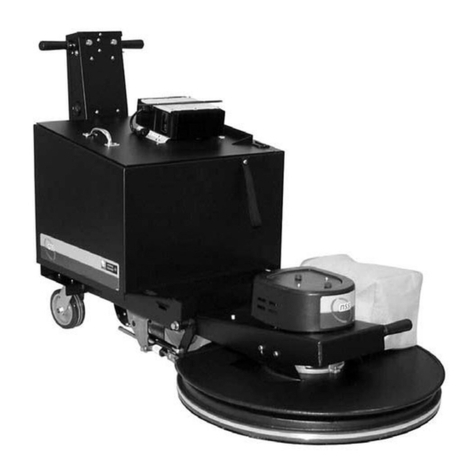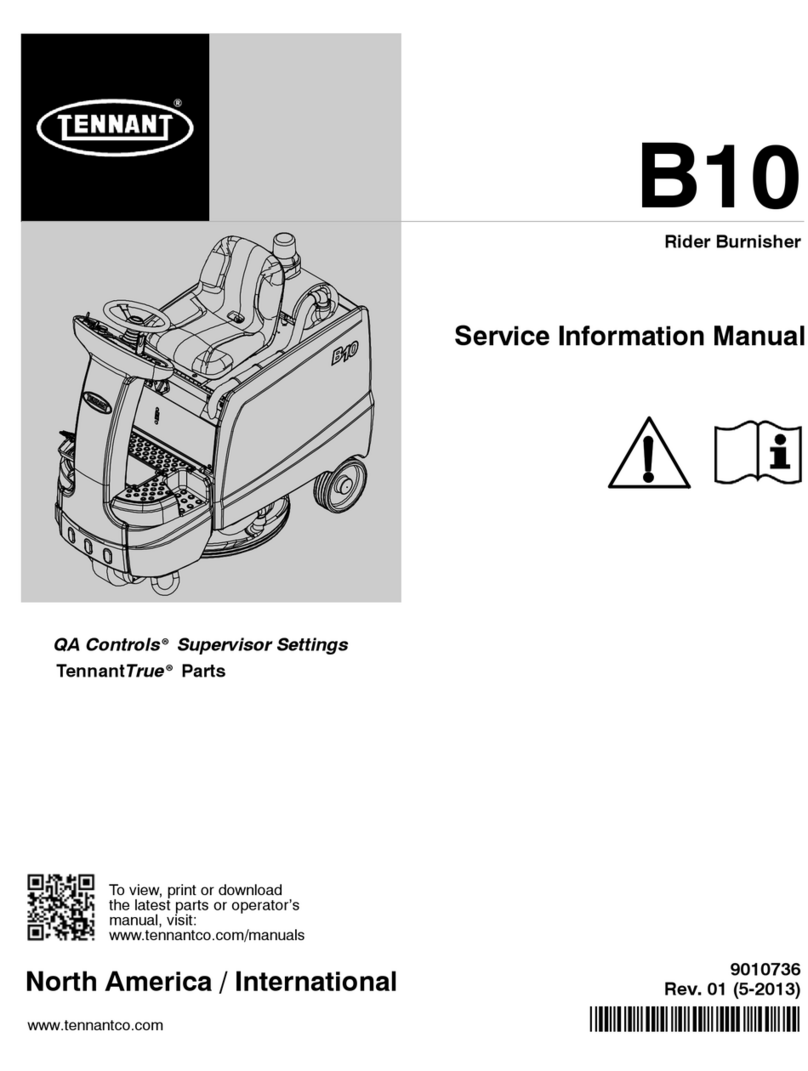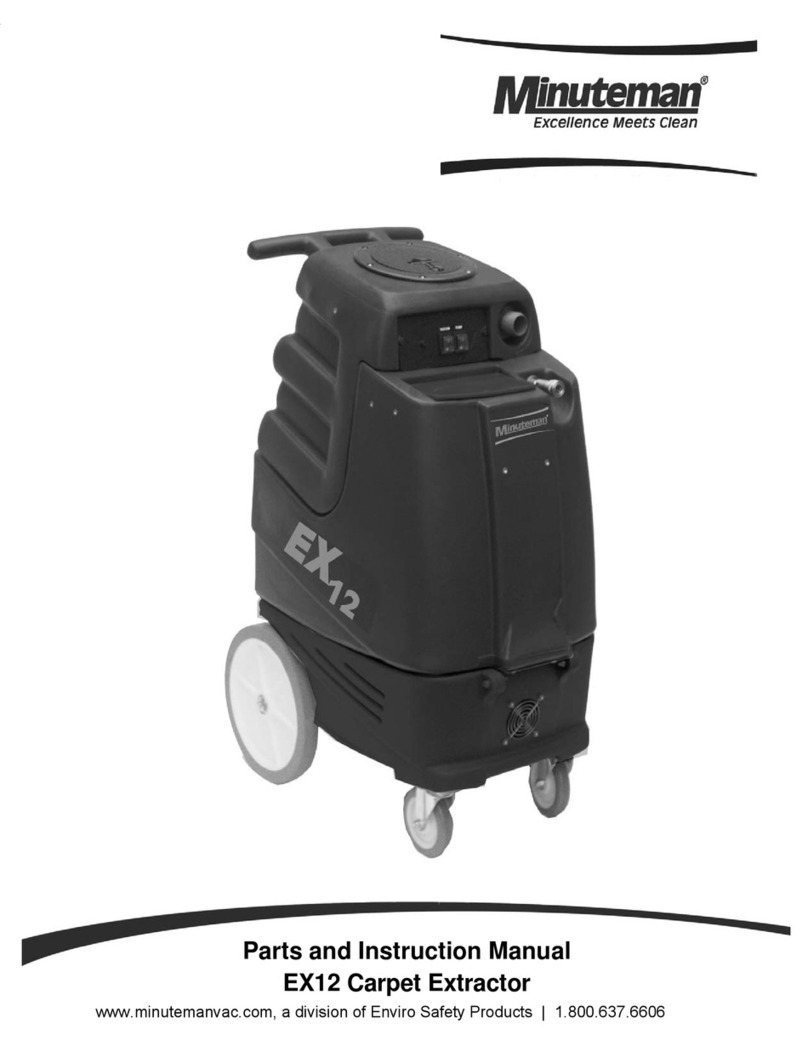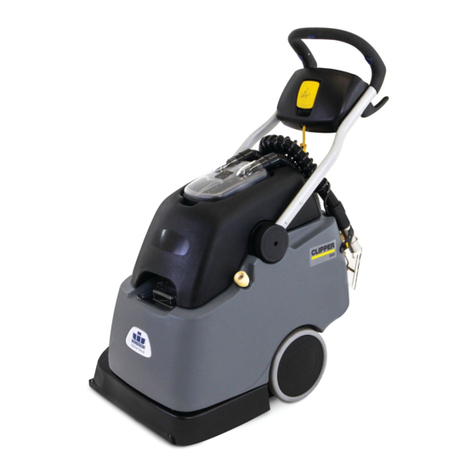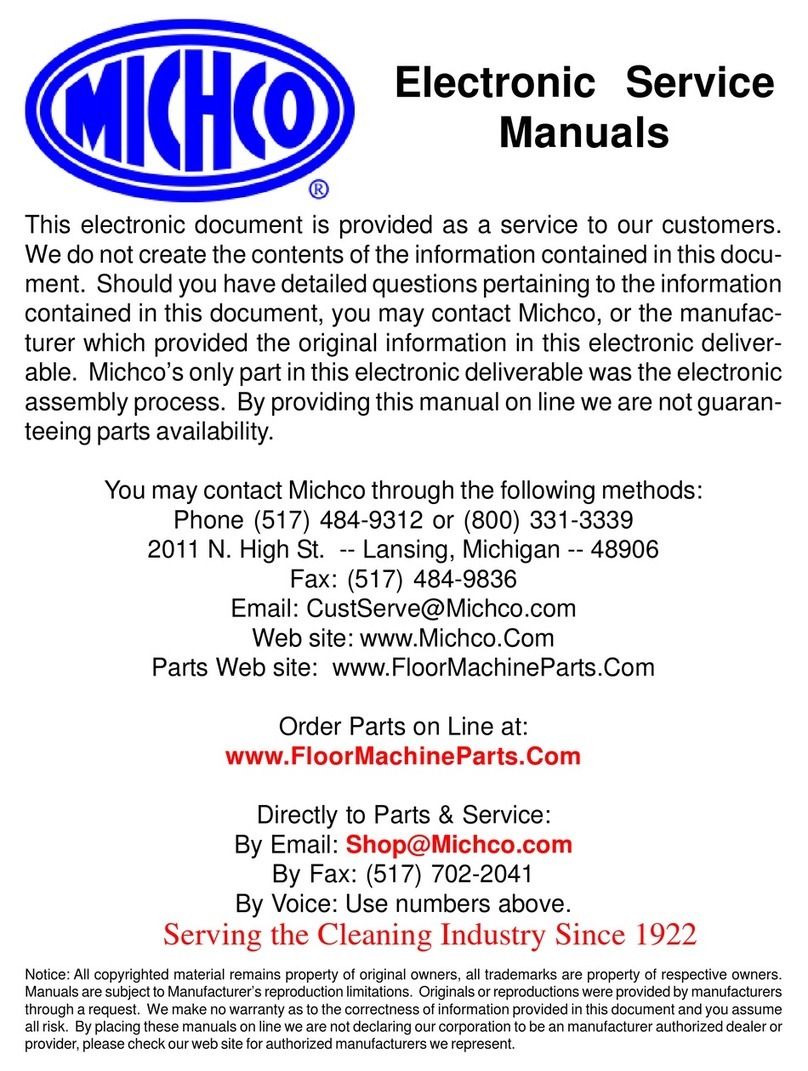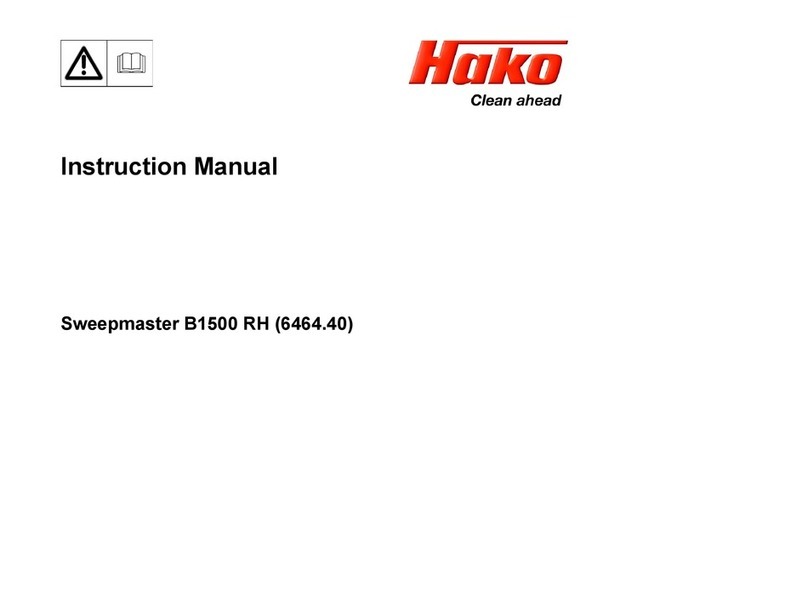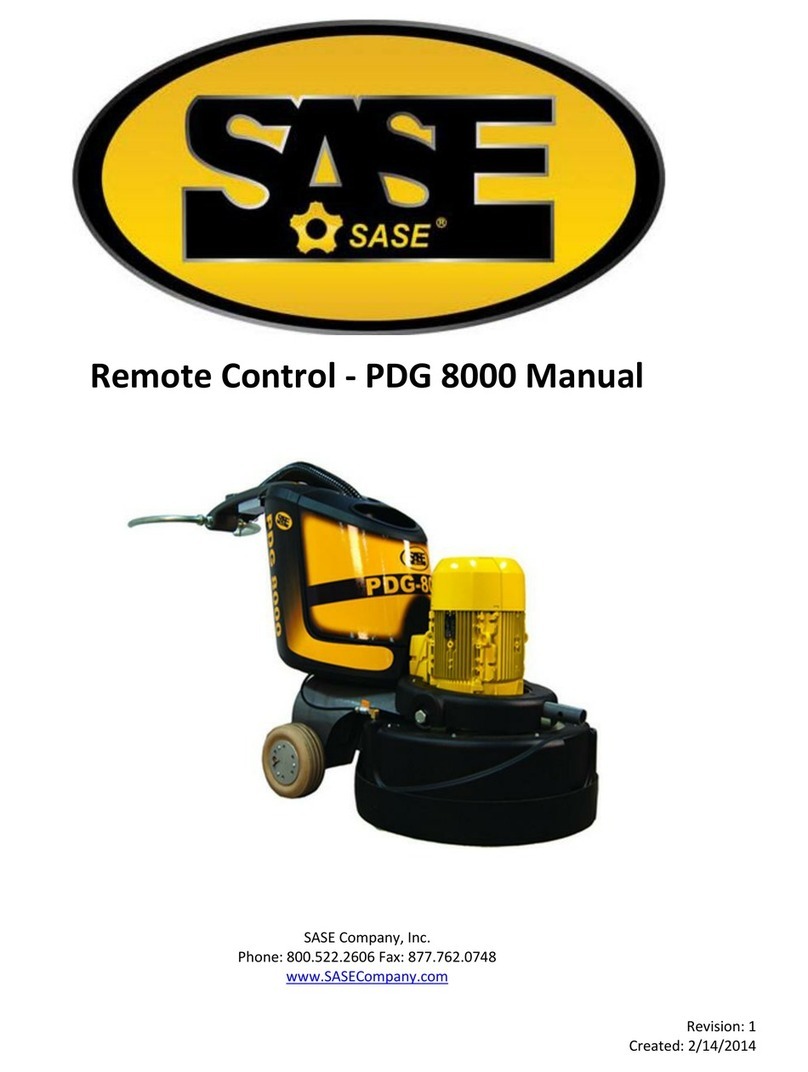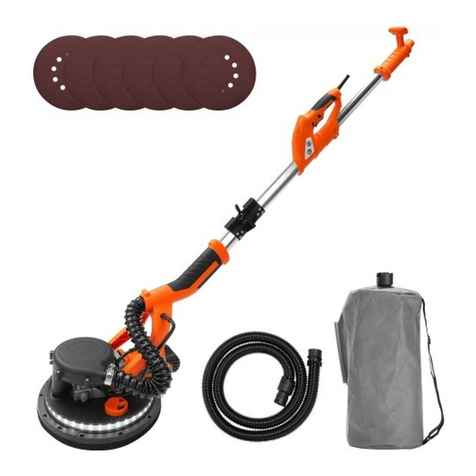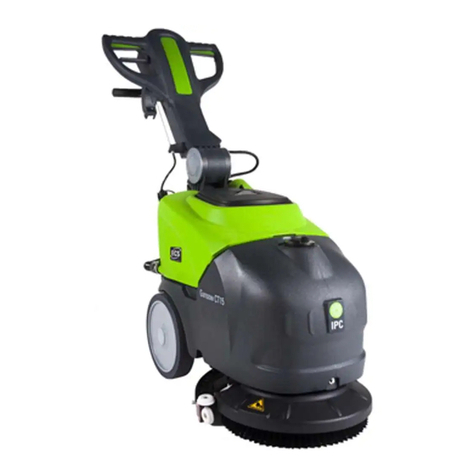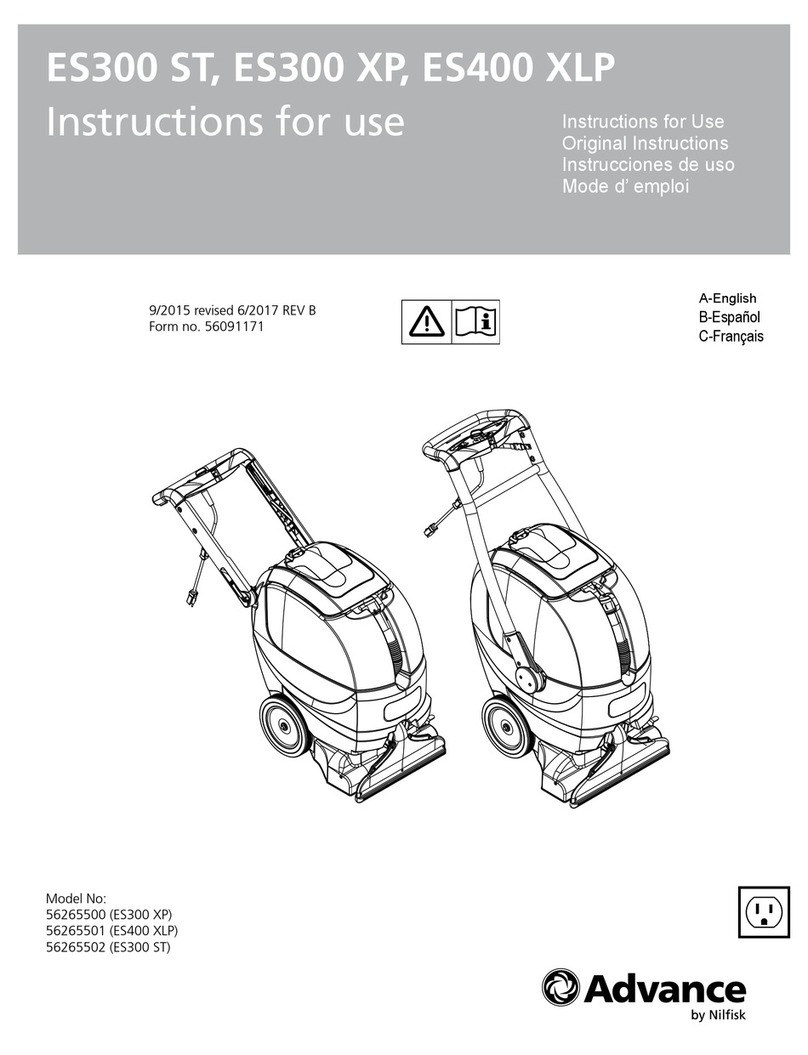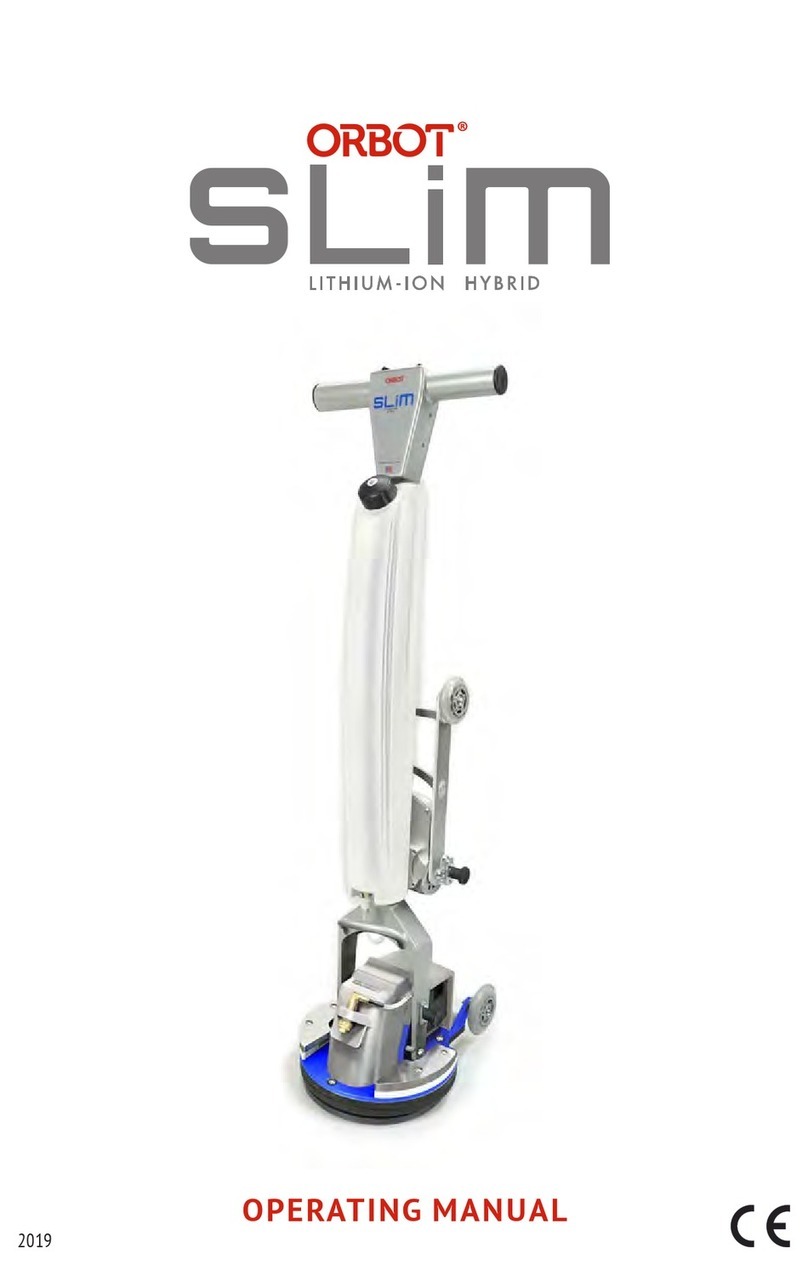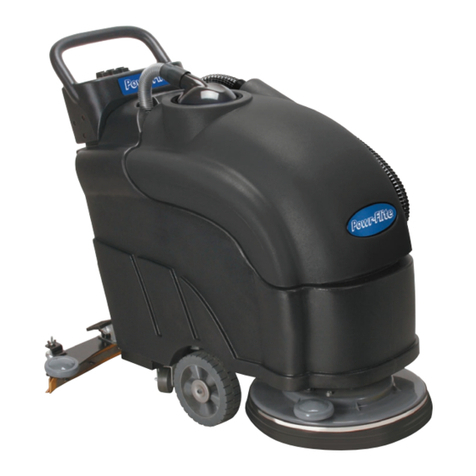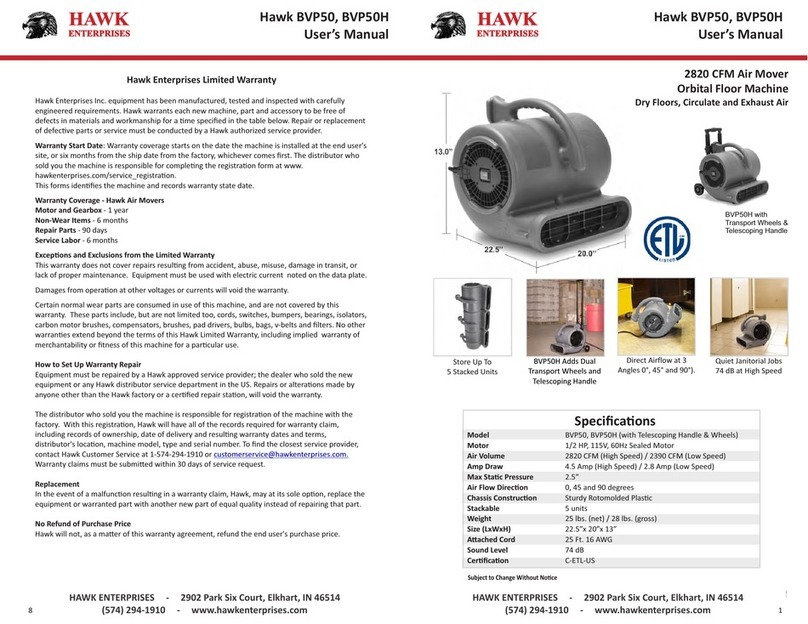NSS STALLION 12 SC User manual

OPERATION MANUAL
STALLION 12 SC CARPET EXTRACTOR
SAVE THESE INSTRUCTIONS
ALL REPAIR SERVICE MUST BE PERFORMED
BY AN NSS AUTHORIZED DISTRIBUTOR /
ERVICE STATION USING ONLY NSS ORIGINAL EQUIPMENT PARTS.
ICE STATION USING ONLY NSS ORIGINAL EQUIPMENT PARTS.
S
IMPORTANT SAFETY INSTRUCTIONSIMPORTANT SAFETY INSTRUCTIONS
Read all instructions before using or servicing machine.Read all instructions before using or servicing machine.
WARNING: Shock or electrocution hazard.WARNING: Shock or electrocution hazard.
ALWAYS unplug machine before
performing any maintenance or service.
ALWAYS unplug machine before
performing any maintenance or service.
WARNING: Shock or electrocution hazard.WARNING: Shock or electrocution hazard.
NEVER connect this machine to an
electrical outlet that is not properly
grounded. See grounding instructions.
NEVER connect this machine to an
electrical outlet that is not properly
grounded. See grounding instructions.
WARNING: Fire or explosion hazard.
NEVER use to pick up flammable or
combustible liquids, or any thing that is
burning or smoking, such as cigarettes,
matches or hot ashes.
WARNING: Fire or explosion hazard.
NEVER use to pick up flammable or
combustible liquids, or any thing that is
burning or smoking, such as cigarettes,
matches or hot ashes.
NEVER operate this machine in an
explosive atmosphere (grain dust,
flammable liquids or fumes, etc…)
NEVER operate this machine in an
explosive atmosphere (grain dust,
flammable liquids or fumes, etc…)
WARNING:To reduce the risk of fire, electric shock, or injury:WARNING:To reduce the risk of fire, electric shock, or injury:
INTENDED USEINTENDED USE
The Stallion 12 SC Carpet Extractor is intended for
commercial use, cleaning and extracting floors, furniture,
draperies and automobile interiors in an indoor
environment. This machine is intended for Wet pickup
only. NSS does not recommend using these machines
for any other purpose.
The Stallion 12 SC Carpet Extractor is intended for
commercial use, cleaning and extracting floors, furniture,
draperies and automobile interiors in an indoor
environment. This machine is intended for Wet pickup
only. NSS does not recommend using these machines
for any other purpose.
When Using An Electrical Appliance, Basic
Precautions Should Always Be Followed,
Including The Following:
When Using An Electrical Appliance, Basic
Precautions Should Always Be Followed,
Including The Following:
•ALWAYS read and understand all instructions before
operating or servicing machine.
•ALWAYS read and understand all instructions before
operating or servicing machine.
•ALWAYS use this machine ONLY as described in this
manual.
•ALWAYS use this machine ONLY as described in this
manual.
•NEVER attempt to operate this machine unless you
have been trained in its operation.
•NEVER attempt to operate this machine unless you
have been trained in its operation.
•NEVER allow an untrained person to operate this
machine.
•NEVER allow an untrained person to operate this
machine.
•NEVER leave the machine plugged in to the electrical
outlet when not in use.
•NEVER leave the machine plugged in to the electrical
outlet when not in use.
•NEVER unplug the machine from an electrical outlet
until after the machine is turned off.
•NEVER unplug the machine from an electrical outlet
until after the machine is turned off.
•If appliance is not working as it should, has been
dropped, damaged, left outdoors, or dropped into
water, return it to a service center.
•If appliance is not working as it should, has been
dropped, damaged, left outdoors, or dropped into
water, return it to a service center.
•NEVER operate this machine in standing water.•NEVER operate this machine in standing water.
•NEVER disconnect or modify any switches or safety
devices.
•NEVER disconnect or modify any switches or safety
devices.
•NEVER operate this machine if the cord and / or plug
has been damaged, broken, cut, abraded or taped.
•NEVER operate this machine if the cord and / or plug
has been damaged, broken, cut, abraded or taped.
•ALWAYS replace the entire cord when the cord or
plug is damaged in any way.
•ALWAYS replace the entire cord when the cord or
plug is damaged in any way.
•NEVER handle the machine, cord, or plug with wet
hands.
•NEVER handle the machine, cord, or plug with wet
hands.
•NEVER drop or insert any object into any machine
opening.
•NEVER drop or insert any object into any machine
opening.
•NEVER operate this machine with any air opening
blocked. Keep all air openings free of dust, lint, hair,
etc.
•NEVER operate this machine with any air opening
blocked. Keep all air openings free of dust, lint, hair,
etc.
•NEVER pull or carry the machine by its electrical
supply cord, use the cord as a handle, close a door on
the cord, pull the cord around sharp edges or corners,
expose to heated surfaces, run machine over cord, or
set heavy or sharp objects on the cord.
•NEVER pull or carry the machine by its electrical
supply cord, use the cord as a handle, close a door on
the cord, pull the cord around sharp edges or corners,
expose to heated surfaces, run machine over cord, or
set heavy or sharp objects on the cord.
•NEVER unplug by pulling on the cord. To unplug the
cord from the outlet, grasp the plug, not the cord.
•NEVER unplug by pulling on the cord. To unplug the
cord from the outlet, grasp the plug, not the cord.
•NEVER allow this machine to be used as a toy. Close
attention is necessary when used by or near children.
•NEVER allow this machine to be used as a toy. Close
attention is necessary when used by or near children.
•ALWAYS keep face, fingers, hair or any other body
part or loose clothing away from any machine opening
or moving part.
•ALWAYS keep face, fingers, hair or any other body
part or loose clothing away from any machine opening
or moving part.
•ALWAYS use extreme care when cleaning on stairs
or when machine is placed on stairs.
•ALWAYS use extreme care when cleaning on stairs
or when machine is placed on stairs.
•NEVER operate the machine without the filters in
place.
•NEVER operate the machine without the filters in
place.
•ALWAYS place this machine on a firm flat surface.•ALWAYS place this machine on a firm flat surface.
•NEVER use any attachments other than the
manufacturers recommended attachments.
•NEVER use any attachments other than the
manufacturers recommended attachments.
•NEVER spray this machine with water or any liquids.•NEVER spray this machine with water or any liquids.
•NEVER operate this machine outdoors.•NEVER operate this machine outdoors.
•NEVER expose the machine to rain, snow, or extreme
temperatures.
•NEVER expose the machine to rain, snow, or extreme
temperatures.
•NEVER use this machine for dry vacuuming.•NEVER use this machine for dry vacuuming.
•ALWAYS store this machine indoors in a dry, cool
area.
•ALWAYS store this machine indoors in a dry, cool
area.
Stallion 12 SC O
p
eration Manual Ori
g
. 05-07 9094813

MANUEL D'UTILISATION
STALLION 12 SC CARPET EXTRACTOR
IMPORTANTES INSTRUCTIONS DE SÉCURITÉ
Lisez toutes les instructions avant d’utiliser ou de réparer et faire l’entretien de l’appareil.
AVERTISSEMENT : Danger de choc
ou d'électrocution.
CONSERVER CES INSTRUCTIONS
TOUJOURS débrancher l'appareil
avant tout entretien ou réparation.
AVERTISSEMENT : Danger de choc
ou d'électrocution.
NE JAMAIS brancher cet appareil à
une prise électrique qui n'est pas mise
à la terre correctement. Voir les
instructions de mise à la terre.
AVERTISSEMENT : Danger d'incendie ou
d'explosion.
NE JAMAIS utiliser pour ramasser des liquides
inflammables ou combustibles ou toute autre
chose qui brûle ou fume, comme des
cigarettes, des allumettes ou des cendres
chaudes.
NE JAMAIS faire fonctionner cet appareil dans
un milieu explosif (poussière céréalière,
liquides ou fumées inflammables, etc.)
AVERTISSEMENT:
UTILISATION PRÉVUE
L'extracteur de tapis Stallion 12 SC est un appareil à
utilisation commerciale, pour nettoyer et extraire les
planchers, les meubles, les tentures et l'intérieur des
voitures dans un milieu intérieur. Cet appareil est réservé
au ramassage humide. NSS ne recommande pas
d'utiliser ces appareils à d'autres fins.
En utilisant un appareil électrique, on doit
suivre les précautions de bas, y compris ce
qui suit:
•TOUJOURS lire et comprendre toutes les instructions
avant d'utiliser ou de réparer l'appareil.
•TOUJOURS utiliser l'appareil SEULEMENT selon la
description dans ce manuel.
•NE JAMAIS essayer de faire fonctionner cet appareil à
moins d'être formé pour son utilisation.
•NE JAMAIS permettre à une personne non formée de
faire fonctionner cet appareil.
•NE JAMAIS laisser l'appareil branché dans la prise de
courant lorsqu'il n'est pas utilisé.
•NE JAMAIS débrancher l'appareil de la prise de
courant avant qu'il ne soit éteint.
•SI l’appareil ne fonctionne pas correctement, a été
échappé, endommagé, laissé à l’extérieur ou échappé
dans l’eau, retournez-le à un centre de service.
•NE JAMAIS faire fonctionner cet appareil dans de l'eau
stagnante.
•NE JAMAIS débrancher ou modifier les interrupteurs
ou les dispositifs de sécurité.
•NE JAMAIS faire fonctionner cet appareil si le cordon
et / ou la fiche est endommagé(e), brisé(e), coupé(e),
usé(e) ou scellé(e) avec un ruban adhésif.
•TOUJOURS remplacer tout le cordon lorsque ce
dernier ou la fiche est endommagé(e) de quelque façon
que ce soit.
•NE JAMAIS manipuler l'appareil, le cordon ou la fiche
avec les mains mouillées.
•NE JAMAIS laisser tomber ou insérer un objet dans
toute ouverture de l'appareil.
Pour réduire le risque d’incendies, de choc électrique ou de
blessures.
•NE JAMAIS faire fonctionner cet appareil lorsqu'une
ouverture d'air est bloquée. Garder toutes les ouvertures
d'air libres de poussières, peluche, cheveux, etc.
•NE JAMAIS tirer ou porter l'appareil par son cordon
électrique, utiliser le cordon comme poignée, fermer
une porte sur le cordon, tirer le cordon autour de bords
ou coins tranchants, exposer à des surfaces chauffées,
faire passer l'appareil sur le cordon, ou déposer des
objets lourds ou tranchants sur le cordon.
•NE JAMAIS débrancher en tirant le cordon. Pour
débrancher le cordon de la prise, agripper la fiche non
pas le cordon.
•NE JAMAIS laisser cet appareil servir de jouet.
Attention tout particulièrement lorsque l'appareil est
utilisé par ou près d'enfants.
•TOUJOURS garder le visage, les doigts, les cheveux
ou toute autre partie du corps ou vêtements amples
loin de toute ouverture de l'appareil ou pièce mobile.
•TOUJOURS utiliser l'appareil prudemment en nettoyant
les escaliers ou lorsque l'appareil lui-même est sur
l'escalier.
•NE JAMAIS faire fonctionner l'appareil sans que les
filtres ne soient en place..
•TOUJOURS placer cet appareil sur une surface ferme
et à plat.
•NE JAMAIS utiliser d'accessoires autres que ceux
recommandés par le fabricant.
•NE JAMAIS pulvériser cet appareil d'eau ou d'autres
liquides.
•NE JAMAIS faire fonctionner l'appareil à l'extérieur.
•NE JAMAIS exposer l'appareil à la pluie, à la neige ou
à des températures extrêmes.
•TOUJOURS ranger cet appareil à l'intérieur dans un
endroit sec et frais.
TOUTES LES RÉPARATIONS DOIVENT ÊTRE EFFECTUÉES PAR UN DISTRIBUTEUR / STATION SERVICE
AUTORISÉ(E) NSS UTILISANT SEULEMENT DES PIÈCES ORIGINALES NSS.

IMPORTANT SAFETY INSTRUCTIONS
GROUNDING OF ELECTRICAL EQUIPMENT
WARNING: Improper connection of the equipment–grounding
conductor can result in a risk of electric shock. Check with a qualified
electrician or service person if you are in doubt as to whether the outlet
is properly grounded. Do not modify the plug provided with the machine
– if it will not fit the outlet; have a proper outlet installed by a qualified
electrician.
Always use a properly grounded 3-wire extension cord no less than
12-3 ST, which has male and female plugs.
GROUNDING INSTRUCTIONS
This machine shall be grounded while in use to protect the operator from electric shock. The machine
is provided with a three-conductor cord and a three-contact grounding type attachment plug. The plug
must be plugged into a grounded outlet that is properly installed and grounded in accordance with all
local codes and ordinances. The green conductor in the cord is the ground wire. Never connect this
wire to other than the grounding pin of the attachment plug.
Check nameplate on the machine to be sure voltage and cycle stated is the same as the electrical
outlet. Do not attempt to plug a 120-volt machine into a 240-volt outlet or a 240-volt machine into a
120-volt outlet. If the machine is provided with an attachment plug as shown in Figure A. below, it is
intended for use on a nominal 120-volt circuit. If a properly grounded receptacle as shown in Figure A.
is not available, an adapter may be installed as shown in Figure B. if the outlet box that houses the
receptacle is grounded. Be sure to fasten the grounding tab (the green colored rigid ear, lug or the like
extending from the adapter) with a metal faceplate screw.
If the machine is provided with an attachment plug as shown in Figure C., it is intended for use on a
nominal 240-volt circuit. No adapter is available for this plug.
NOTE: In Canada, the use of a temporary adaptor is not permitted by Canadian electrical code.
ALL REPAIR SERVICE MUST BE PERFORMED BY AN NSS AUTHORIZED
DISTRIBUTOR / SERVICE STATION USING ONLY NSS ORIGINAL EQUIPMENT
SAVE THESE INSTRUCTIONS

IMPORTANTES INSTRUCTIONS DE SÉCURITÉ
MISE À LA TERRE DE L'ÉQUIPEMENT ÉLECTRIQUE
AVERTISSEMENT: Toute mauvaise connexion de l'appareil-
conducteur de mise à la terre peut mener à un risque de choc
électrique. Vérifier auprès d'un électricien ou d'un réparateur qualifié si
vous avez des doutes quant à la mise à la terre appropriée de la prise.
Ne pas modifier la fiche fournie avec l'appareil – si elle n'entre pas dans
la prise, faire installer une prise appropriée par un électricien qualifié.
Toujours utiliser une rallonge à 3 fils mise à la terre et à prises mâle et
femelle.
INSTRUCTIONS DE MISE À LA TERRE
Cet appareil doit être mis à la terre lorsqu'il est en marche pour protéger l'opérateur de tout choc
électrique. L'appareil est fourni avec un cordon à 3 conducteurs et une fiche de branchement masse à
trois contacts. La fiche doit être branchée dans une prise appropriée, installée et mise à la terre
correctement selon tous les codes et ordonnances locaux. Le conducteur vert du cordon est le fil de
masse. Ne jamais brancher ce fil à autre chose que la broche de masse de la fiche de branchement.
Vérifier la plaque signalétique de l'appareil pour être certain que la tension et le cycle indiqués sont
les mêmes que la prise électrique. Ne pas essayer de brancher un appareil de 120 volts à une prise de
240 volts ou un appareil de 240 volts à une prise de 120 volts. Si l'appareil est fourni avec une fiche de
branchement tel qu'indiqué dans la figure A. plus bas, il doit donc être utilisé avec un circuit nominal de
120 volts. S'il n'y a pas de prise mise à la terre telle qu'indiqué dans la figure A. disponible, on peut
installer un adaptateur tel qu'indiqué dans la figure B. si la boîte à prises est mise à la terre. S'assurer
d'attacher la patte de mise à la terre (boucle, cosse rigide de couleur verte ou quelque chose de
semblable sortant de l'adaptateur) avec une vis de plaque signalétique de métal.
Si l'appareil est fourni avec une fiche de branchement tel qu'indiqué dans la figure C., il doit donc être
utilisé avec un circuit nominal de 240 volts. Il n'y a aucun adaptateur disponible pour cette fiche.
REMARQUE : Au Canada, l'utilisation d'un adaptateur temporaire est interdite par le code d'électricité canadien.
TOUTES LES RÉPARATIONS DOIVENT ÊTRE EFFECTUÉES PAR UN DISTRIBUTEUR / STATION
SERVICE AUTORISÉ(E) NSS UTILISANT SEULEMENT DES PIÈCES ORIGINALES NSS.
CONSERVER CES INSTRUCTIONS

NOISE AND VIBRATION
NOISE
Sound pressure level at Operator
position
77dB(A)
MACHINE INSPECTION
•After the machine is unpacked, remember to recycle
all packing materials.
•Inspect the machine for damage or missing
components. If damage is found, contact the local
freight company to file a freight claim.
•Note: this machine is shipped with antifreeze in the
solution line system to protect the pump and valves
from freezing during transport and storage. Before
you use the machine, rinse the solution line system
with clean water (See Preparing the Machine).
MACHINE COMPONENTS
Solution Tank
The solution tank is the lower part of the machine
body. It has a capacity of 12 Gallons (45 liters).
Recovery Pails
The (2) recovery pails are the upper part of the
machine body. The pails each have a capacity of 6
gallons (23 liters).
Control Panel
The operator control panel is located on the handle of
the machine. This panel has components that control
various machine functions:
•The left rocker switch turns the vacuum motor on
and off.
•The right rocker switch turns the brush motor on and
off.
•The middle rocker switch controls the pump.
•The carpet spray switch (located below the left grip
handle) allows the liquid to be sprayed onto the
carpet. Press and hold the switch to start spraying
the liquid, release the switch to stop.
•The circuit breaker on the right side of the handle
protects the brush motor.
Cleaning Solution Flow Rate Valve
This machine has a two position valve located on the
lower rear panel that will allow the operator to use less
cleaning chemical for light duty applications.
•The low flow position provides a 38% reduction in the
cleaning solution consumption.
•The high flow position provides full capacity solution
application.
Brush Head Assembly
This machine has a floating brush head assembly that
adapts to the different carpet pile heights. The brush
head is offset to the right side of the machine to clean
against the wall.
•The brush head assembly includes the Spray Bar.
•Two brass spray jets provide a cleaning pattern over
the full width of the brush head.
Vacuum Shoe
The 16” (41 cm) wide vacuum shoe is located at the
front of the machine. As the machine moves backward
the vacuum shoe pulls the liquid out of the carpet.
Accessory hose option
•Remove the 2” hose adapter connection from the
machine.
•Attach the 1 ½” hose assembly with adapter plate to
the vacuum lid inlet.
•Pull back female quick disconnect sleeve on the
hose and convert to the male plug on the back of the
machine.
PREPARING THE MACHINE
Preparing the Solution and Recovery tanks:
•Never use water over 140°F (60°C).
•Before initial use, purge the antifreeze used for
shipping from the solution line system using clean
water only. Flush the system out completely.
•Excessively hot water will damage components such
as the pump, valves, and seals. Observe the carpet
manufacturer’s cleaning instructions.
•Make sure the solution indicator tube is securely
clipped in the upright position to keep fluids from
draining out.
•Put 1 to 2 gallons (4 to 8 liters) of water in the
solution tank first to help dilute the chemicals and
prevent excess sudsing. Dilute the cleaning
chemicals according to the manufacturer’s
instructions.
•Fill the tank by pouring the water and cleaning
chemicals through the mesh filter that covers the
opening at the front of the solution tank.
•Ensure Recovery pails are in position.
•Always use a defoamer in the Recovery pails to
protect the vacuum motor of this machine.
•Every time the solution tank is filled, add 2 to 3
ounces (60 to 90 milliliters) of defoamer to each
Recovery pail.
•Make sure the vacuum lid fits securely to the
recovery pails for an air-tight seal. The vacuum
motor will pull the lid down (creating suction) during
use.
Connect the Power Cord
This machine is equipped with a twist lock power cord.
•Align the three electrical contacts, push the contacts
together and turn one of the plugs 1/8 of a turn to
lock the two plugs in place. This will prevent the
machine from disconnecting during use.
Brush motor circuit breaker
If the brush becomes over loaded by deep pile carpet,
hair, strings or an obstruction the motor will draw too
much current and the circuit breaker will trip.

MACHINE OPERATION
This machine is very maneuverable and is designed
to clean as you pull backwards across the carpet.
When moving forward, always push down on the
handle to raise the front of the machine up and move
on all four wheels.
Normal Cleaning
•Always vacuum the carpet with a vacuum cleaner
before extraction.
•We recommend you wear clean tennis shoes or
non-slip shoes when working with a carpet
extractor. Street shoes or rubber cushion soled
shoes when wet will release absorbed dirt or
grease onto the wet carpet and cause re-soiling.
•You may need to pre-treat spots and heavy traffic
lanes before extraction. Refer to the “Common
Stains and Cleaning Treatments” chart for
examples of types of stains and the solution used
to treat the stain.
•Soak up excess liquids with a towel.
•Test cleaner on a small inconspicuous area to
make sure it will not damage the carpet fibers.
•Apply appropriate spotter, following directions on
the container.
•You may apply the pre-treat chemicals in a number
of ways:
•Use a hand held spray bottle.
•Use a 2 - 3 gallon (7 - 8 liter) pump up container
with a spray wand.
•Use the machine spray bar, by tilting the machine
backwards slightly away from the carpet. Press
and hold the carpet spray switch (located below
the left handle grip) to apply the chemical.
•Plug the machine into an appropriate wall outlet.
•Turn on the Vacuum, Pump, and Brush switches.
•Extract the perimeter of the room first, move the
vacuum shoe as close to the wall or baseboard as
possible. Use the right side of the machine to
clean against the wall for best results.
•Start on one side of the room and work your way
across the room in rows, always working away
from the cord.
•Lift up on the handle grips to ensure that the
vacuum shoe rests on the carpet.
•Press and hold the carpet spray switch to start
spraying and begin moving backwards. About 6"
(15 cm) before your stopping point, release the
carpet spray switch to stop spraying, and continue
moving backwards to recover all of the solution you
have just applied. This will prevent leaving an
excessively wet spot in the carpet. Move machine
forward on all four wheels to start the next path,
overlap 2” (5 cm) for best results. Continue
cleaning the entire area in this method.
•Monitor the solution level using the solution
indicator tube on the back left of the machine.
NOTE: If dirty solution does not appear through the
vacuum lid, check:
The vacuum lid is properly seated on the
recovery pails.
The machine’s vacuum shoe is touching the
carpet in working mode.
The solution tank is not empty.
NOTE: If foam appears on the vacuum lid, turn the
Vacuum switch off immediately and add more
defoamer to the recovery pails to dissolve the foam
or empty the recovery pails.
•As you clean, keep an eye on the liquid level in the
recovery pails. Empty the recovery pails as
needed during operation.
•When the solution tank runs empty, turn off the
vacuum, pump, and brush switches. Empty the
recovery pails and rinse thoroughly. Repeat the
procedures on Preparing the Machine as required.
Do not apply water more than twice in one area to
prevent excess wetting.
•Over-wetting can damage the carpet and the
underlying floor.
•If the brush becomes over loaded by deep pile
carpet, hair, strings, or an obstruction the motor will
draw too much current and the circuit breaker will
trip.
•Unplug the machine, check for debris, and remove
it.
•Push down on the circuit breaker to reset it and
resume operation.
SPECIAL CLEANING
This machine may be used to perform special
cleaning jobs other than “normal” scrubbing.
Double Scrubbing
This procedure provides deeper cleaning on heavily
soiled floors.
•Double scrub by making a second pass over the
carpet with only the brush turned on. Then, make
a third pass with the solution pump, vacuum and
brush on to remove the most dirt. Make an
additional vacuum pass to dry the carpet as much
as possible.
•The slower the cleaning pass, the more dwell time,
increasing the amount of dirt that is removed from
the carpet.

OPTION - ACCESSORY CLEANING
Preparing the Accessories:
•Select the correct tool for the job to be performed.
•Connect the solution hose to the quick connect at
the back, lower left side of the machine and on the
tool.
•To connect a tool, pull back on the collar of the
quick connect, insert one end of the solution hose
fitting and push it in until it locks. Attach the other
end of the solution hose to the tool in the same
manner.
•Remove the machine hose from the right side of
the vacuum lid and insert one end of the recovery
hose into the lid. Attach the other end of the hose
to the accessory tool.
Cleaning upholstery, stairs or confined areas:
•Prepare the solution / recovery tanks as you would
for normal carpet cleaning.
•To begin cleaning, turn on the rocker switch for the
solution pump and vac motor only. When you
squeeze the trigger of the accessory tool it will
spray the cleaning solution, release the trigger to
stop the spray.
•Do not apply water more than twice in one area
to prevent excess wetting.
•Over-wetting can damage upholstery and / or
fabric.
Priming the Solution Pump
During normal use the clean solution tank may run
dry. This will allow air to enter the pump and solution
lines. Air in the solution lines will prevent the pump
from working properly, you must prime the pump.
•Refill the solution tank.
•Disconnect any accessory tool that may be in use.
CAUTION - place machine near a floor drain prior to
the next step.
•Turn on the solution pump switch.
•Depress the center pin in the accessory quick
connect for 60 - 90 seconds (minimum). The pump
will spray air and solution out until all of the air has
been forced from the solution lines. When all of the
air has been expelled you may resume your
cleaning operation.
NOTE: The solution pump will not prime through the
spray jets or an accessory tool.

MACHINE MAINTENANCE
Routine maintenance is critical to ensure proper
machine operation and cleaning performance.
Perform all maintenance procedures as follows.
Always turn OFF all machine switches before
performing any maintenance.
DAILY MAINTENANCE
At the end of the day empty all liquids from both the
solution and recovery tanks. Rinse both tanks with
clean water to prevent chemical residue build up,
allow to air dry to prevent orders.
•Coil power cord onto the cord wrap.
•Remove dirt and/or lint build-up inside the vacuum
lid filter screen.
•Clean the solution line filter.
•Wash the vacuum lid with a soap solution to
prevent dirt from accumulating on the surface. To
avoid scratching, use of a soft cloth is
recommended.
•The solution tank can be emptied by: spraying the
liquid out through the spray bar, or using the
solution indicator tube.
•To use the solution indicator tube, unclip from the
machine handle and place the end into a recovery
pail.
•The recovery pails are emptied by lifting up the
vacuum lid and removing the pails from the
machine by using their handles. Drain the liquids
according to your local EPA regulations.
•Rinse the solution tank clean of all debris.
•Store in a dry area.
•Lean the machine back on all four wheels during
storage or when it’s not in use to prevent brush
distortion.
•Check the drain hose for damage.
•Remove the spray tips (1/4 turn) from the spray bar
and put them in a glass or plastic container with a
solution of 25% vinegar and water overnight to
remove any chemical residue.
•Unplug the machine and inspect the brush
assembly (paying special attention to the ends of
the rollers) for buildup of carpet fibers, hair or other
materials.
•Remove all debris from the brush. Failure to
remove this material can overload to the circuit
breaker, jam and break the belt, obstruct and
damage the bearings, or burn out the brush drive
motor.
Weekly Maintenance (25 Hours)
•Verify all daily and weekly maintenance has been
performed.
•Flush clean solution tank and hoses with a mixture
of 8 ounces (250 milliliters) white vinegar to one-
gallon (4 liter) warm water.
•Remove and clean the filter solutions screen by
rinsing under running tap water. If the screen is
clogged with soap, soak in vinegar solution and
brush clean.
•Check the vacuum lid screens for any debris or
obstruction. Clean by rinsing under running tap
water. If the screen is clogged with soap, soak in
vinegar solution and brush clean.
•Check the vacuum shoe for any debris or
obstruction such as carpet fibers. Carefully
remove any debris to ensure the best air-flow and
liquid recovery.
•Apply a lubricant (WD-40 or equivalent) to the
quick disconnect coupler to help prevent sticking.
•Repair or replace any worn or damaged
components as needed.
Mandatory Periodic Maintenance
It is mandatory that the following maintenance
procedure be performed at the described interval.
Failure to perform this procedure may result in poor
machine performance, machine component damage
and failure. This procedure should be performed by
an NSS authorized distributor or service center.
Repairs performed by an unauthorized company will
void the machine warranty. If you require assistance
finding an authorized service center, please contact
NSS Enterprises, Inc.
After every 750 hours of operation
•Inspect the vacuum motor carbon brushes for
wear. Replace the vacuum motor carbon brushes
when they are 7/16in. (11mm) in length.
•Check the belt for wear and tightness.

COMMON STAINS AND CLEANING TREATMENTS
TREATMENT METHODS
•Remove excess material; if the stain is liquid blot excess liquids with a dry cloth or paper towel, if the material is a
solid remove it by scraping it with a dull edge (butter knife).
•Clean the remaining stain as directed by the chart below. Always follow the directions on the container. Apply the
cleaning material directly to the stain (avoid over wetting the carpet or upholstery). Remove the loosened stain
material with a white absorbent cloth, tissue, or paper towel.
•When the carpet is dry, gently brush the carpet pile to restore its appearance.
•Treat unknown stains with a volatile solvent first and follow with other agents as required. If you are uncertain of the
effect of the cleaning agent on the carpet fiber or dye, test on an inconspicuous area first.
STAIN TYPE TREATMENT MATERIAL
Asphalt Volatile solvent / detergent
Beer Liquid detergent, White vinegar
Berry Stain Liquid detergent, Ammonia 3 - 6%, Water
Bleach Liquid detergent, Water
Blood (dried) Warm detergent, Ammonia 3 - 6%, Water
Blood (wet) Liquid detergent, Water
Butter Volatile solvent
Catsup or Mustard Liquid detergent
Chewing Gum Volatile solvent
Chocolate Liquid detergent, Ammonia 3-6%, Water
Coffee Detergent, White vinegar, Volatile solvent
Cola Drink Liquid detergent
Crème de Menthe (green) Liquid detergent
Egg (raw) Liquid detergent
Food Dye Liquid detergent, Water
Furniture Dye Polish Paint/Oil/Grease remover, Detergent
Gravy Liquid detergent
Lipstick Paint / Oil / Grease remover,
Mascara Paint remover, Volatile solvent, Detergent, Water
Milk Liquid detergent
Orange Drink Liquid detergent, Water
Shoe Polish Heated iron into clean towel, Volatile solvent
Tea Liquid detergent
Tomato Juice Liquid detergent
Urine Liquid detergent, Water
Vomit Warm detergent, Water, White vinegar
Wine Liquid detergent, Ammonia 3 - 6%, Water, Vinegar

TROUBLESHOOTING
Symptom Cause Solution
Spray nozzle tips plugged. Disassemble and clean.
Solution tank empty. Refill.
Pump failed. Repair or replace as required.
Defective pump seal. Replace pump.
Debris in check valve. Clear obstruction.
Nozzle gasket obstruction. Replace gasket.
Incorrect spray nozzles. Install correct spray nozzles.
Solenoid valve clogged. Bleed air lock from system.
Worn pump bearing (excessive noise). Repair or replace as required.
Punctured pump diaphragm. Replace diaphragm.
Accumulated dirt on solution intake screen. Clean or replace.
Accumulation of debris inside pump and
plumbing. Disassemble and clean.
No Solution or Uneven
Spray Pattern From
Spray Tips or Accessory
Tool.
Defective rectifier. Replace rectifier.
Carpet Spray is Off but
Solution Still Drips. Debris in solenoid. Clean or replace.
Vacuum lid not sealing. Replace or tighten lid.
Loose vacuum hose, vacuum connection. Tighten connection.
Accumulated dirt on lid screen. Clean lid screen.
Worn vacuum lid gasket. Replace gasket.
Lint & dirt build-up on suction head/brush
chamber. Clean suction head/brush chamber.
Defective vacuum hose. Replace vacuum hose.
Poor Water Pickup.
Loose connection to vacuum motor. Tighten connection.
Internal pump parts worn. Rebuild pump head or replace.
Pump air locked. Bleed air lock from system.
Solenoid valve will not open. Replace solenoid valve.
Pump Runs But Has
Little Or No Output.
Solution tank filter plugged. Clear or replace.
Motor shorted out Replace motor.
Faulty pressure switch. Replace pressure switch.
Faulty pump switch / wiring. Repair or replace.
Damaged power cord. Replace power cord.
Extension cord inadequate. Remove extension cord.
Pump Motor Will Not
Run.
Low voltage. Test wall outlet.
Overloaded circuit breaker. Circuit breaker reset. Unplug other
electrical items on same circuit.
No Electrical Power.
Defective power cord. Replace power cord.
Motor Runs but Brush
Won’t Spin Loose belt. Tighten belt.
Floating Brush Won’t
Move Up and Down. Debris inside the slide block guide. Disassemble and clear obstruction.
NSS®Enterprises, Inc.
3115 Frenchmens Road, Toledo, Ohio 43607
PHONE (419) 531-2121 FAX (419) 531-3761
NSS ® Enterprises, Inc. European Distribution Centre
Unit II, Pinfold Trading Estate * 55 Nottingham Road
STAPLEFORD, NOTTINGHAM NG9 8AD ENGLAND U.K.
PHONE: (44) 0115 939 1568 * FAX: (44) 0115 949 0615
Table of contents
Other NSS Floor Machine manuals
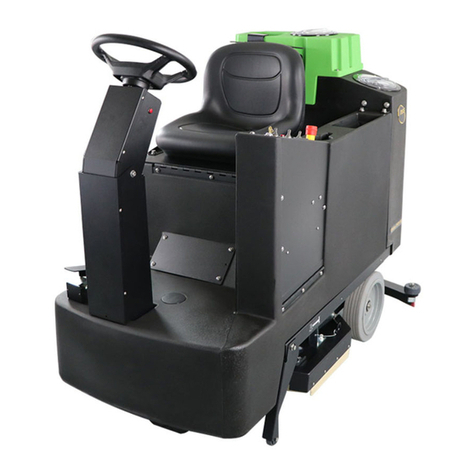
NSS
NSS champ 2929 rb User manual
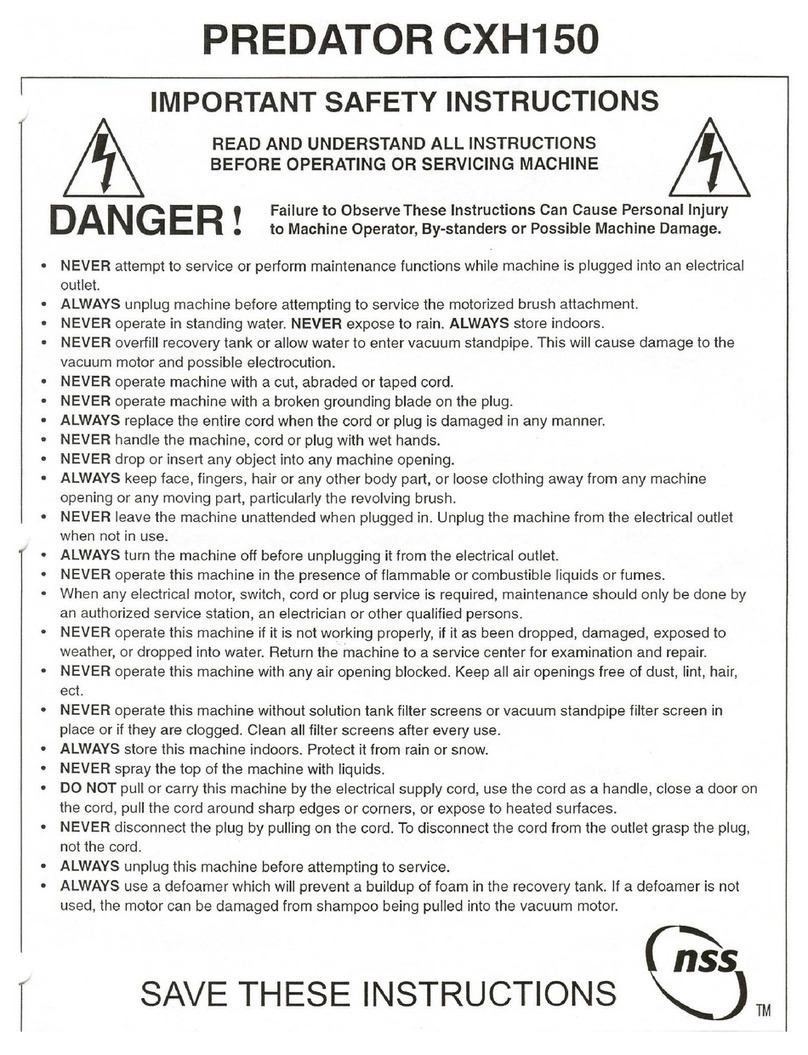
NSS
NSS Predator CXH150 User manual
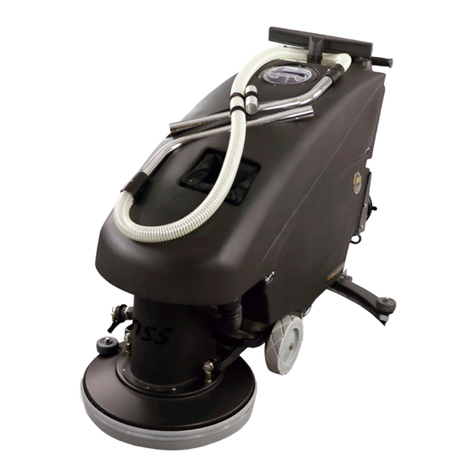
NSS
NSS WRANGLER 2016 AE User manual

NSS
NSS WRANGLER 2016 AB User manual

NSS
NSS Predator CXC 200 User manual

NSS
NSS charger 2000 User manual
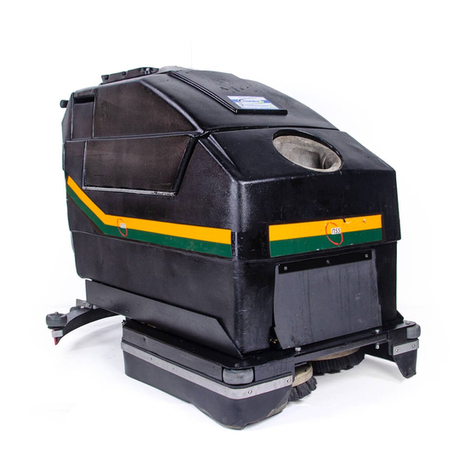
NSS
NSS WRANGLER 2625 DB User manual
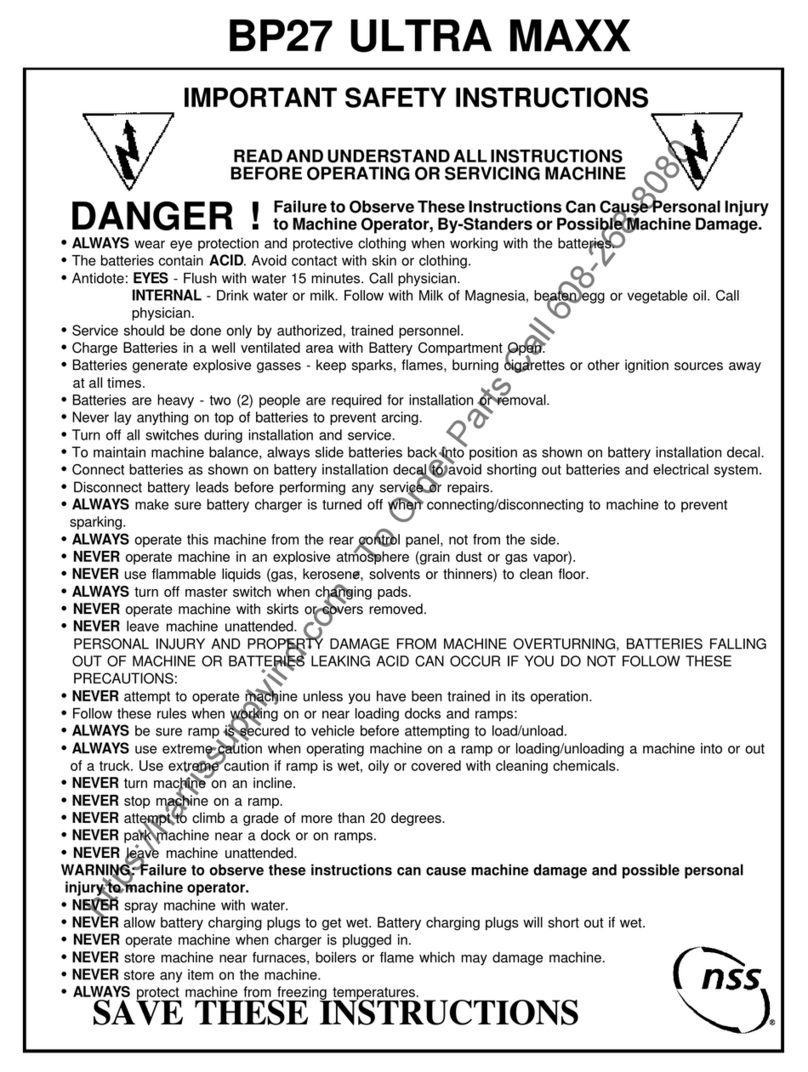
NSS
NSS BP27 ULTRA MAXX User manual
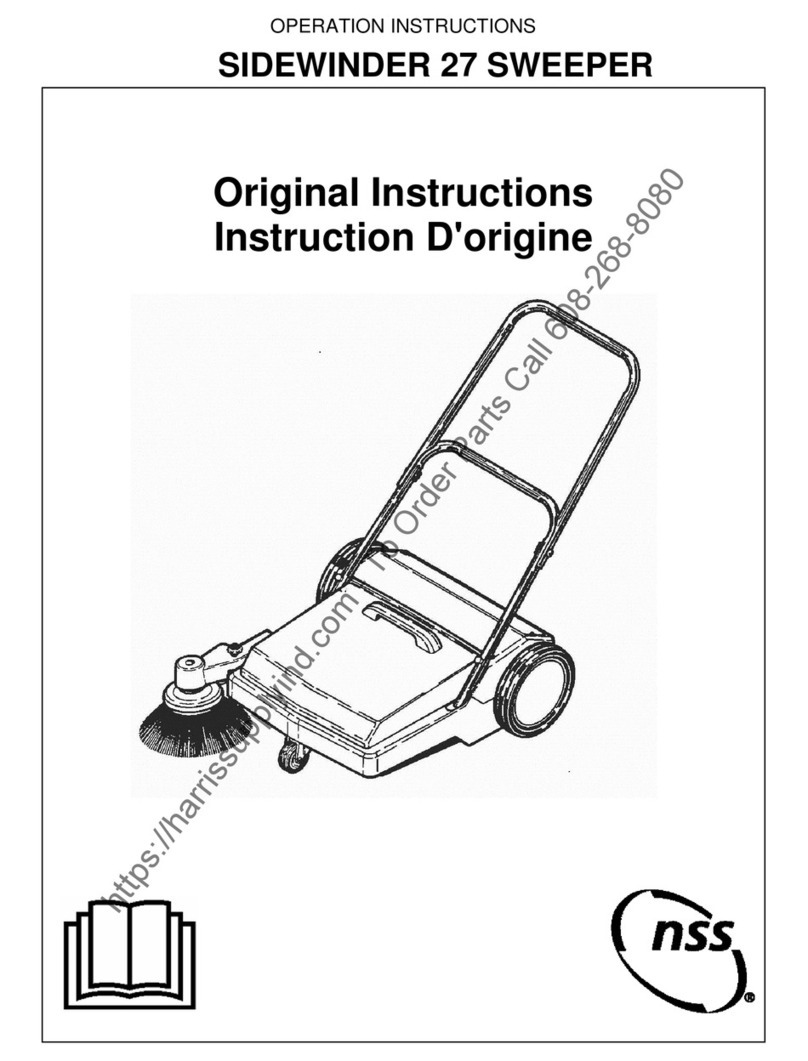
NSS
NSS SIDEWINDER 27 User manual
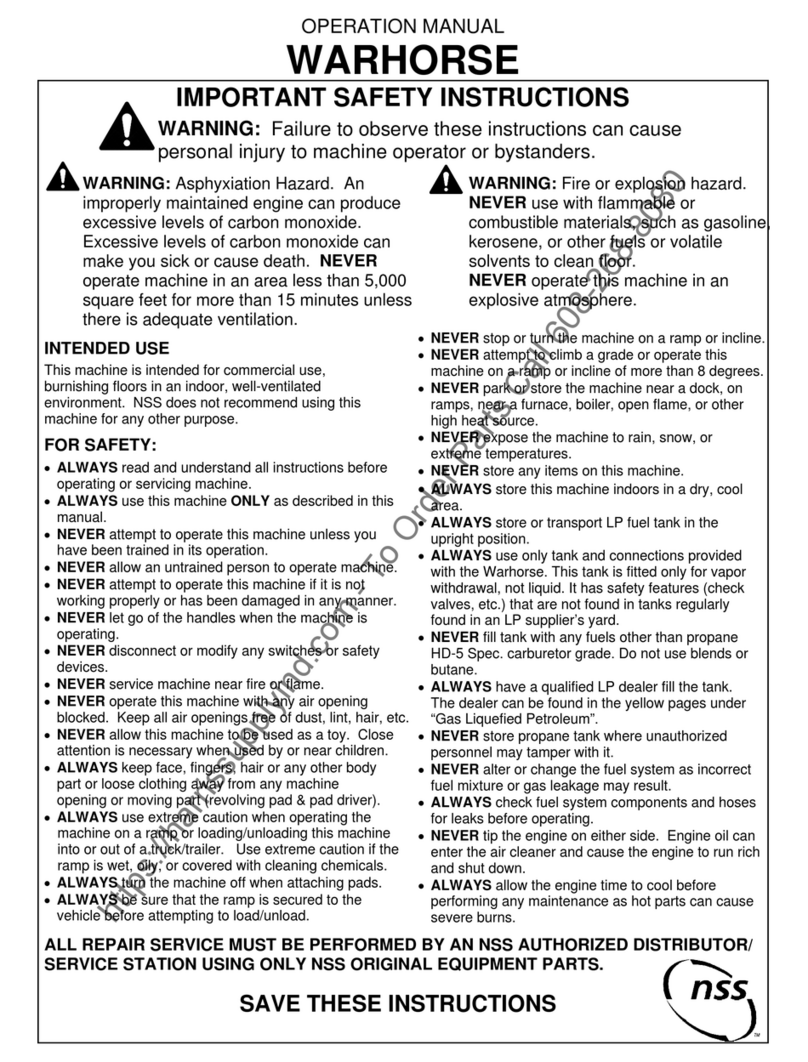
NSS
NSS WARHORSE User manual
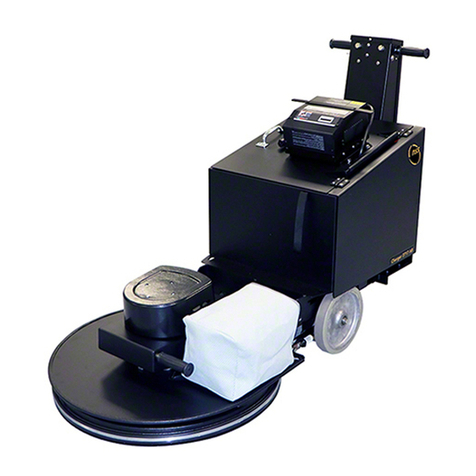
NSS
NSS CHARGER 2717 AB User manual
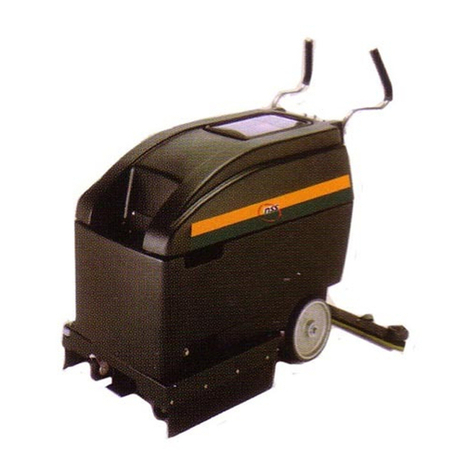
NSS
NSS WRANGLER 1708 AB User manual
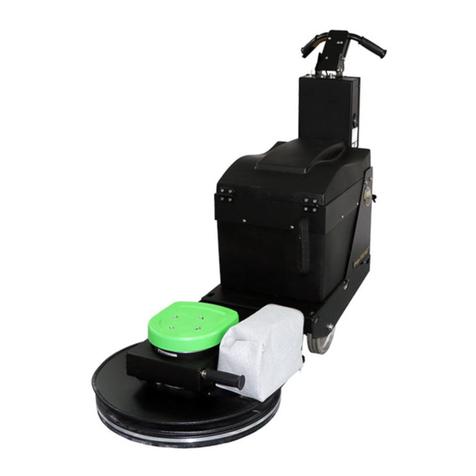
NSS
NSS CHARGER 2022 ABLT User manual
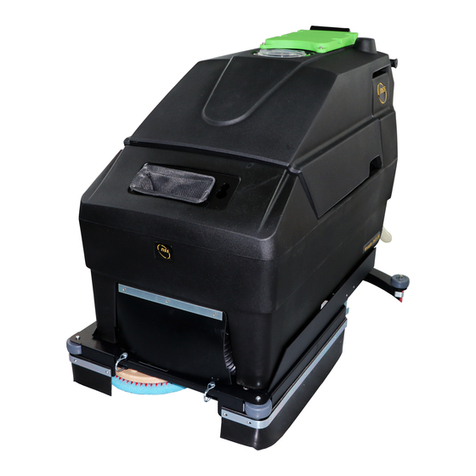
NSS
NSS WRANGLER 26 User manual

NSS
NSS CHARGER 2022 ABLT User manual
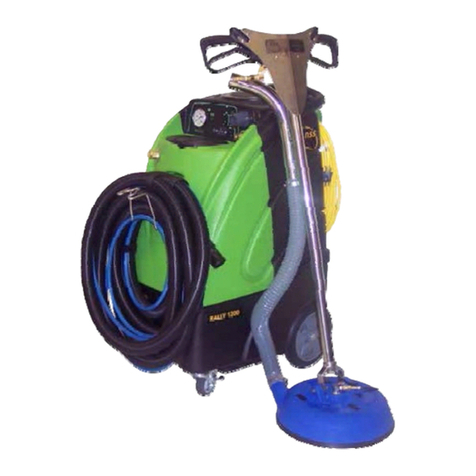
NSS
NSS RALLY 1200 User manual
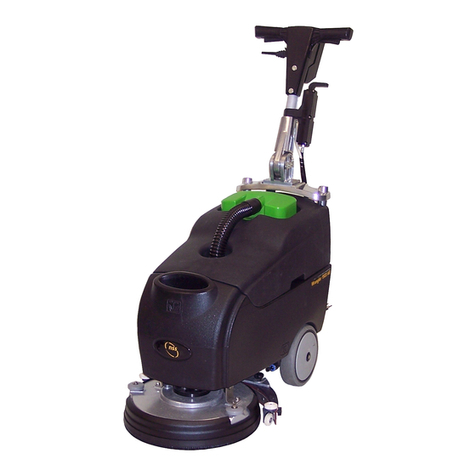
NSS
NSS WRANGLER 1503 AE Operating instructions
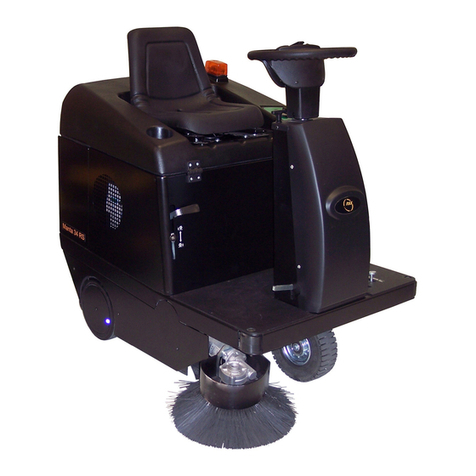
NSS
NSS MANTA 34 RS Manual
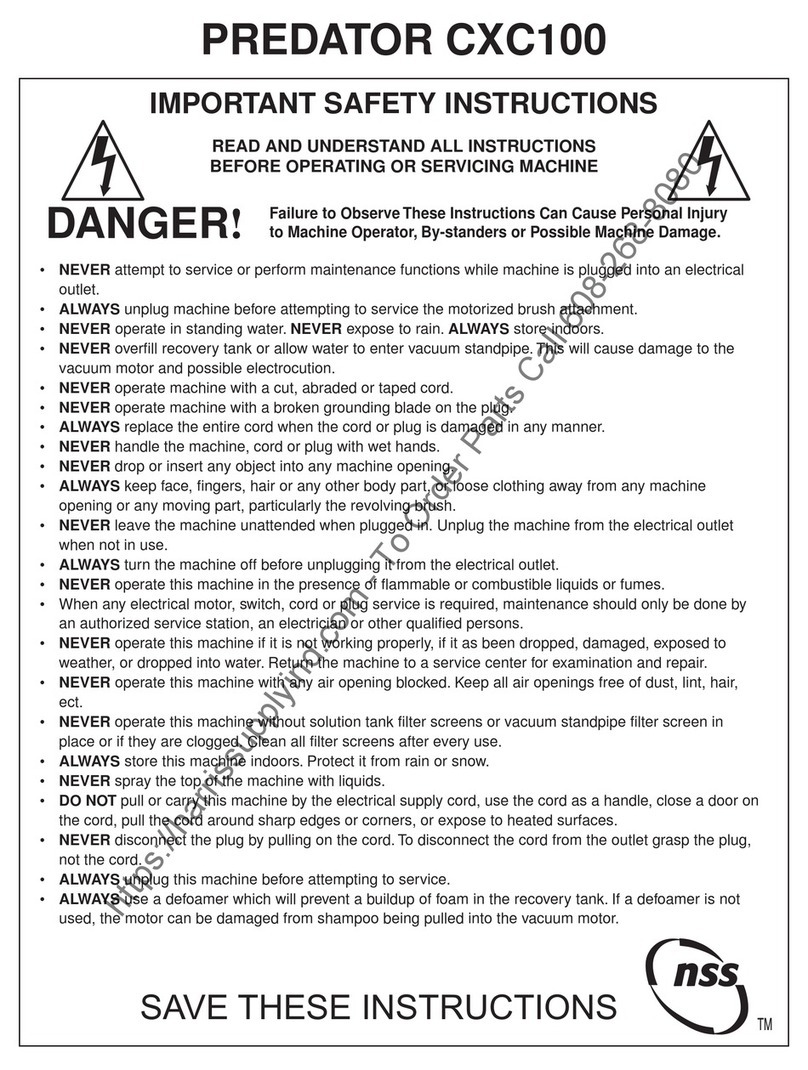
NSS
NSS PREDATOR CXC100 User manual
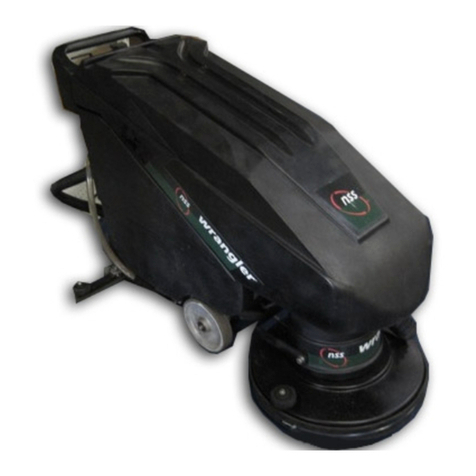
NSS
NSS WRANGLER 20 E User manual
